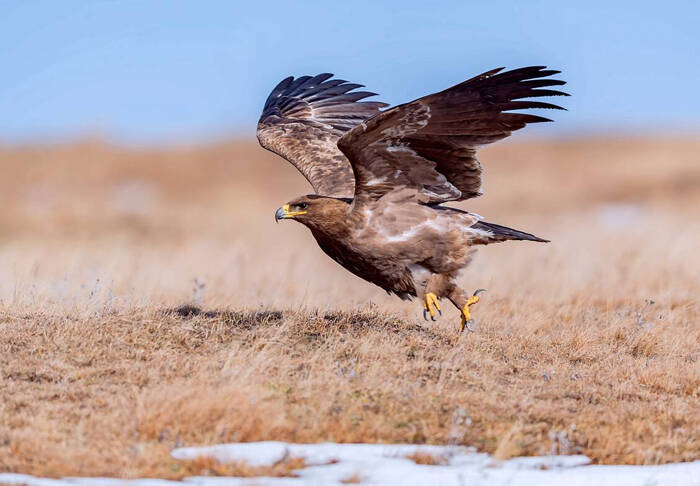Aquila nipalensis
IUCN
LCBasic Information
Scientific classification
- name:Aquila nipalensis
- Scientific Name:Aquila nipalensis,Steppe Eagle,Aigle des steppes, عقاب البادية, عقاب السهول,Flower Eagle, Horned Eagle
- Outline:Raptor
- Family:Falconiformes Accipitridae S.Accipitrinae G.Accipitridae
Vital signs
- length:70-80cm
- Weight:2.4-3.8kg
- lifetime:20-70years
Feature
A dark brown vulture with a fierce appearance.
Distribution and Habitat
Breeding range: Mongolia and Russia.
Non-breeding range: Angola, Bhutan, Botswana, Burundi, Democratic Republic of the Congo, Djibouti, Eritrea, Eswatini, Ethiopia, Kenya, Kuwait, Malawi, Malaysia, Namibia, Nepal, Rwanda, Singapore, Somalia, South Africa, South Sudan, Tanzania, Thailand, Uganda, Zambia and Zimbabwe.
Migrant: Armenia, Azerbaijan, Bahrain, Bulgaria, Georgia, Greece, Israel, Jordan, Lebanon, Oman, Palestine, Qatar, Syria, Tajikistan, Turkey, United Arab Emirates and Uzbekistan.
Resident: Afghanistan, Bangladesh, China, Egypt, India, Iran, Iraq, Kazakhstan, Kyrgyzstan, Myanmar, Pakistan, Saudi Arabia, Sudan, Turkmenistan and Yemen.
Extinct: Moldova, Romania and Ukraine.
Wandering (non-breeding range): Hungary.
Wandering: Albania, Belarus, Cameroon, Chad, Croatia, Czech Republic, Denmark, Estonia, Finland, France, Germany, Italy, North Korea, Mali, Netherlands, Niger, Nigeria, Norway, Poland, Slovakia, Spain, Sweden, Tunisia and Vietnam.
Mainly inhabits
Appearance
It has a fierce appearance and a flat tail. Adult birds are easily confused with other all-dark eagles. The wings have dark trailing edges. Sometimes the large underwing coverts reveal light-colored wing spots like young birds. Due to age and individual differences, the body color varies greatly, ranging from light gray-brown, brown, tan, earthy brown to dark brown. When gliding, it does not raise its wings in a "V" shape like the golden eagle, but stretches its wings flat and slightly lifts them up.
The body feathers of the steppe eagle are mainly brown, with earthy brown on the upper body and darker and thicker on the top of the head. The flight feathers are dark brown, mixed with darker horizontal spots. The inner base of the outer primary taboo feathers has brown and dirty white horizontal spots; the tips of the inner primary flight feathers and secondary flight feathers have triangular brown and white spots; the lower body is dark earthy brown, with brown vertical str
Details
The Steppe Eagle is also known as the Steppe Eagle. It is slightly smaller than the Golden Eagle and the White-shouldered Eagle. It is also a large bird of prey. It is a dark brown eagle with two subspecies.

The steppe eagle (Aquila nipalensis) was once classified as a subspecies of the same species as the tawny eagle (Aquila rapax). However, the two species are independent of each other based on differences in morphology, ecology and behavior.
Steppe eagles are active during the day, or they live on telephone poles, isolated trees and the ground for a long time, or they fly over grasslands and wastelands. They mainly feed on small vertebrates and insects such as yellow mice, jerboas, gerbils, pikas, marmots, hares, sand lizards, grass lizards, snakes and birds, and sometimes they eat animal carcasses and carrion. They mainly forage on the ground or wait at the entrance of marmots and rodents' holes and suddenly pounce on their prey when their prey appears. Sometimes they also observe and look for prey by flying in the air. They fly low when they see their prey, and sometimes they wait at the entrance of mouse holes. They feed on rodents.
The time when steppe eagles hunt is consistent with the activity patterns of rodents, mostly in the morning from 7 to 10 o'clock and in the evening. The main food is rabbits, yellow mice, pikas, jerboas, voles, and martens. In desert areas, they mainly feed on large sand mice.
The breeding season of steppe eagles is from April to June. They nest on cliffs or in rock piles on mountain tops, and also on the ground, on earth piles, haystacks or on hillsides. The shape of the nest is shallow disk, and the nest is mainly composed of dead branches, with dead grass stems, grass leaves, wool and feathers inside. Each nest lays 1-3 eggs, usually 2 eggs, which are white, with no spots or yellow-brown spots on the surface. The long diameter of the egg is between 55-55.5 mm. After the first egg is laid, the eggs begin to be incubated, and the parents take turns to incubate the eggs. The incubation period is about 45 days. The chicks are late-maturing, and after hatching, they are fed by the parents together for 55-60 days before leaving the nest.
Steppe Eagle populations are declining due to habitat destruction (particularly conversion of grasslands to cropland), persecution, and collisions with power lines. Local populations are declining due to extensive predation on Steppe Eagle chicks. In Europe, population sizes are estimated to have declined by 80% or more in 42 years (three generations, as of 2020). But European populations represent only a small fraction of the global population. Total populations across the species' range show a 58.6% decline between 1997-2011 and 2013-2015 (I. Karykin in litt. 2015), but the number of birds passing through the migratory bottleneck in Eilat, Israel, has not shown a significant decline. When comparing data from 1977-1988 and 2015-2018, the average number of birds counted has decreased (19,540-15,192) (Weiss et al. 2019). Overall, the rate of population decline is suspected to be very rapid, exceeding 50% in the past three generations, and in the absence of evidence that the threats affecting the species have been adequately addressed, the decline is suspected to be at this rate in the next three generations.
Listed in the IUCN Red List of Threatened Species 2021 ver3.1 - Endangered (EN).
Listed in Appendix I, II and III of the Convention on International Trade in Endangered Species of Wild Fauna and Flora (CITES) 2019 Edition Appendix II.
Listed in China's National Key Protected Wildlife List (February 5, 2021) Level 1.
Protect wild animals and stop eating game.
Maintaining ecological balance is everyone's responsibility!








